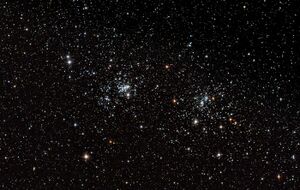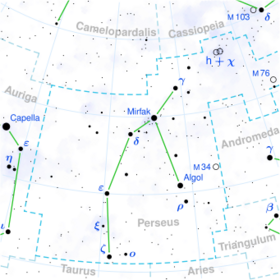Astronomy:V520 Persei
| Observation data Equinox J2000.0]] (ICRS) | |
|---|---|
| Constellation | Perseus |
| Right ascension | 02h 19m 04.45252s[1] |
| Declination | 57° 08′ 07.7951″[1] |
| Apparent magnitude (V) | 6.567[2] (6.52 - 6.67[3]) |
| Characteristics | |
| Spectral type | B3 Ia[4] |
| U−B color index | −0.346[2] |
| B−V color index | +0.452[2] |
| Variable type | IA[3] |
| Astrometry | |
| Radial velocity (Rv) | −43.40[5] km/s |
| Proper motion (μ) | RA: −0.673[1] mas/yr Dec.: −1.098[1] mas/yr |
| Parallax (π) | 0.4348 ± 0.0198[1] mas |
| Distance | 7,500 ± 300 ly (2,300 ± 100 pc) |
| Absolute magnitude (MV) | −7.1[6] |
| Details | |
| Mass | 29.5[7] M☉ |
| Radius | 40.8[7] R☉ |
| Luminosity | 190,000[6] L☉ |
| Surface gravity (log g) | 2.69[7] cgs |
| Temperature | 21,300[7] K |
| Rotation | 66[6] |
| Age | 14[7] Myr |
| Other designations | |
| Database references | |
| SIMBAD | data |
V520 Persei is a blue supergiant member of NGC 869, one of the Perseus Double Cluster open clusters. It is an irregular variable star. At a magnitude of 6.55, V520 Persei is the brightest member in either NGC 869 or NGC 884, although the brighter HD 13994 lies in the foreground along the same line of sight.[2]

The Washington Double Star Catalog lists V520 Per as a double star about 15" from a 13th magnitude A0 companion which is another cluster member. There are dozens of other stars within an arc-minute, including several brighter than 10th magnitude and two 15th magnitude stars closer than the listed companion.[8] The Catalogue of Components of Double and Multiple Stars also lists a single companion, but it is an 11th magnitude star 29" away.[9]
V520 Per is a well-defined member of NGC 869 by location, proper motion, photometry, and spectroscopy, which places it at the same distance of around 7,000 light years.[7] This is supported by the Gaia Data Release 3 parallax of 0.43 mas.[1]

The type of variability is listed in the General Catalogue of Variable Stars as IA, indicating it is poorly studied with no clear period. The visual range is 6.52 - 6.67.[3] Statistical analysis of Hipparcos photometry suggests a possible period of 1.6 days, but the type variability is not clearly defined.[11]
V520 Persei is a supergiant with a spectral class of B3. It also shows some emission lines in its spectrum.[7] It has exhausted its core hydrogen and expanded into a more luminous star fusing hydrogen in a shell or helium in its core. It is over 100,000 times more luminous than the sun, although only thirty times its mass. Much of the luminosity arises from ultraviolet radiation created by the temperature of over 20,000 K.
V520 Per has been identified as one of Flamsteed's "missing stars", catalogue numbers created by Flamsteed but not actually associated with a current star in that constellation. It is described as being 61 Andromedae, although it is well outside the boundary of Andromeda and Flamsteed catalogued other nearby stars in Perseus, for example 7 Persei for χ Per itself.[12]
References
- ↑ 1.0 1.1 1.2 1.3 1.4 1.5 Vallenari, A. et al. (2022). "Gaia Data Release 3. Summary of the content and survey properties". Astronomy & Astrophysics. doi:10.1051/0004-6361/202243940 Gaia DR3 record for this source at VizieR.
- ↑ 2.0 2.1 2.2 2.3 Slesnick, Catherine L.; Hillenbrand, Lynne A.; Massey, Philip (2002). "The Star Formation History and Mass Function of the Double Cluster h and χ Persei". The Astrophysical Journal 576 (2): 880. doi:10.1086/341865. Bibcode: 2002ApJ...576..880S.
- ↑ 3.0 3.1 3.2 Samus, N. N. et al. (2009). "VizieR Online Data Catalog: General Catalogue of Variable Stars (Samus+ 2007-2013)". VizieR On-line Data Catalog: B/GCVS. Originally Published in: 2009yCat....102025S 1. Bibcode: 2009yCat....102025S.
- ↑ Kraus, M.; Borges Fernandes, M.; Kubát, J. (2009). "Parameters of galactic early B supergiants. The influence of the wind on the interstellar extinction determination". Astronomy and Astrophysics 499 (1): 291. doi:10.1051/0004-6361/200810319. Bibcode: 2009A&A...499..291K.
- ↑ Famaey, B.; Jorissen, A.; Luri, X.; Mayor, M.; Udry, S.; Dejonghe, H.; Turon, C. (2005). "Local kinematics of K and M giants from CORAVEL/Hipparcos/Tycho-2 data". Astronomy and Astrophysics 430 (1): 165–186. doi:10.1051/0004-6361:20041272. ISSN 0004-6361. Bibcode: 2005A&A...430..165F.
- ↑ 6.0 6.1 6.2 Crowther, P. A.; Lennon, D. J.; Walborn, N. R. (2006). "Physical parameters and wind properties of galactic early B supergiants". Astronomy and Astrophysics 446 (1): 279–293. doi:10.1051/0004-6361:20053685. Bibcode: 2006A&A...446..279C.
- ↑ 7.0 7.1 7.2 7.3 7.4 7.5 7.6 Marsh Boyer, Amber N.; McSwain, M. Virginia; Aragona, Christina; Ou-Yang, Benjamin (2012). "Physical Properties of the B and Be Star Populations of h and χ Persei". The Astronomical Journal 144 (6): 158. doi:10.1088/0004-6256/144/6/158. Bibcode: 2012AJ....144..158M.
- ↑ Mason, Brian D.; Wycoff, Gary L.; Hartkopf, William I.; Douglass, Geoffrey G.; Worley, Charles E. (2001). "The 2001 US Naval Observatory Double Star CD-ROM. I. The Washington Double Star Catalog". The Astronomical Journal 122 (6): 3466. doi:10.1086/323920. Bibcode: 2001AJ....122.3466M.
- ↑ Dommanget, J.; Nys, O. (1994). "Catalogue des composantes d'etoiles doubles et multiples (CCDM) premiere edition - Catalogue of the components of double and multiple stars (CCDM) first edition". Com. De l'Observ. Royal de Belgique 115: 1. Bibcode: 1994CoORB.115....1D.
- ↑ "Hipparcos Tools Interactive Data Access". ESA. https://www.cosmos.esa.int/web/hipparcos/interactive-data-access.
- ↑ Lefèvre, L.; Marchenko, S. V.; Moffat, A. F. J.; Acker, A. (2009). "A systematic study of variability among OB-stars based on HIPPARCOS photometry". Astronomy and Astrophysics 507 (2): 1141. doi:10.1051/0004-6361/200912304. Bibcode: 2009A&A...507.1141L.
- ↑ Wagman, M. (1987). "Flamsteed's Missing Stars". Journal for the History of Astronomy 18 (3): 209–223. doi:10.1177/002182868701800305. Bibcode: 1987JHA....18..209W.
 |

